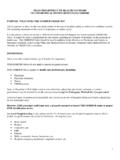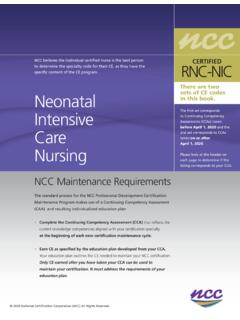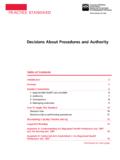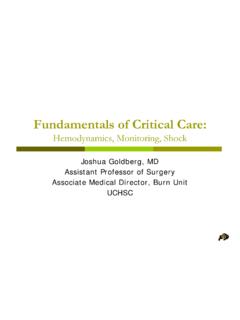Transcription of Standards Mandating Capnography Monitoring
1 Mandating Capnography 131/01/2011 14:58:052 AAAAPSF (American Association for Accreditation of Ambulatory Plastic Surgery Facilities, Inc.)2003 ANESTHESIA Monitoring - applicable to all as noted by:.. Monitoring of end tidal expired CO2 including volume, Capnography /Capnometry, or mass spectros-copy 1999 Every patient receiving general anesthesia shall have the adequacy of ventilation continually evaluated. Qualitative clinical signs such as chest excursion, observation of the reservoir breathing bag and aus-cultation of breath sounds are useful.
2 Continual Monitoring for the presence of expired carbon dioxide shall be performed unless invalidated by the nature of the patient, procedure or equipment. Quantita-tive Monitoring of the volume of expired gas is strongly encouraged. (The mandatory use of CO2 Monitoring will apply to wherever drugs that are capable of interfering with airway protective reflexes are given. ) (General anesthesia, Procedural Sedation, Analgesia) (Intubated, non- intubated, in and out of the OR)AAMS (Association of Air Medical Services) 2004 Equipment specific to a critical patient: Include but not limited to:1.
3 Invasive monitors Swan Ganz, arterial lines, CVP, ICP needle2. Cardiac Assist Devices pacemakers, intra-aortic balloon pump, ventricular assist device, extra- corporeal support (ECMO), 12 lead Monitoring , interpretation and intervention3. Specialty Drug Delivery epidural catheters, intra-osseous lines4. Respiratory equipment ventilators, artificial airways, chest tubes, capnographyAAP (American Academy of Pediatrics)2006 Health care providers should confirm endotracheal tube placement immediately after intubation, dur-ing transport and whenever the patient is moved.
4 Exhaled CO2 should be monitored in patients with an endotracheal tube both in the pre-hospital and hospital settings, as well as during all transport, by using a colorimetric detector or Capnography . 2004 Guidelines and Levels of Care for Pediatric Intensive Care Units Respiratory Equipment Mechanical ventilators suitable for pediatric patients of all sizes must be available for each level I and level II PICU bed. Equipment for chest physiotherapy and suctioning, spirometers, and oxygen analyz-ers must always be available for every patient.
5 Oxygen monitors (pulse oximeters and transcutaneous oxygen monitors) and CO2 monitors (transcutaneous and end-tidal) are required; portable (transport) ventilators are desired. 231/01/2011 14:58:093 American Academy of Pediatrics, American Academy of Pediatric Dentistry 2006 Expired carbon dioxide Monitoring is valuable to diagnose the simple presence or absence of respira-tions, airway obstruction, or respiratory depression, particularly in patients sedated in less accessible lo-cations, such as MRI or computerized axial tomography devices or darkened rooms.
6 The use of expired carbon dioxide Monitoring devices is encouraged for sedated children particularly in situations where other means of assessing the adequacy of ventilation are limited. AARC (American Association for Respiratory Care) 2007BA The bronchoscopy assistant must be trained in Monitoring and evaluating the patient s clinical condition as reflected by pulse oximetry, Capnography , electrocardiogram, and stability of or changes in mechanical ventilation parameters, and be capable of relating changes in clinical condition to disease state, procedure, or drugs administered for the procedure.
7 BA MONITORINGP atient Monitoring should be done before, at regular intervals during, and after bronchoscopy until the patient meets appropriate discharge criteria. For no or minimal sedation, less Monitoring is necessary. For moderate and deep sedation, more Monitoring should be done. The following should be monitored before, during, and/or after bronchoscopy, continuously, until the patient returns to his pre-sedation level of consciousness. SpO2, FIO2 and etCO22003 Capnography should not be mandated for all patients receiving mechanical support, but it may be indi-cated for: Evaluation of the exhaled [CO2], especially end-tidal CO2; Monitoring severity of pulmonary disease and evaluating response to therapy; as an adjunct to determine that tracheal rather than esopha-geal intubation has taken place; continued Monitoring of the integrity of the ventilatory circuit; evalua-tion of the efficiency of mechanical ventilatory support.
8 Monitoring adequacy of pulmonary, systemic, and coronary blood flow; Monitoring inspired CO2 when CO2 is being therapeutically administered; graphic evaluation of the ventilatory-patient interface; measurement of the volume of CO2 elimination to assess metabolic rate and/or alveolar and Complications: Warns against the addition of excessive weight on the endotracheal tube. American Academy of Sleep Medicine 2007 Standard 10: The comprehensive polysomnogram must record sufficient data for sleep stage scoring and evaluation of major sleep disorders.
9 Parameters must include: ECG, EOG, chin and leg EMG, respi-ratory Monitoring , oxygen saturation, and 13: The laboratory must have written protocols for the 331/01/2011 14:58:14413d: Other Monitoring procedures employed at the laboratory such as infant and pediatric polysomnography, actigraphy, maintenance of wakefulness testing, Capnography , and tempera-ture (American College of Emergency Physicians)2009 ACEP Policy Statement revised and approved by the ACEP Board of Directors April 2009.
10 ETT PlacementEnd-tidal carbon dioxide detection is the most accurate technology to evaluate endotracheal tube posi-tion in patients who have adequate tissue perfusion. Properly placed endotracheal tubes may become displaced due to movement of patients and/or equipment. Continuous assessment of correct endotra-cheal tube placement with continuous end-tidal carbon dioxide Monitoring is Godwin SA, Caro DA, Wolf SJ, Jagoda AS, Charles R, Marett BE, Moore J, American College of Emer-gency Physicians.





